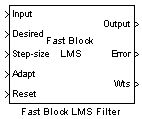Fast Block LMS Filter
Compute output, error, and weights using LMS adaptive algorithm
Library
Filtering / Adaptive Filters
dspadpt3
Description
The Fast Block LMS Filter block implements an adaptive least mean-square (LMS) filter, where the adaptation of the filter weights occurs once for every block of data samples. The block estimates the filter weights, or coefficients, needed to convert the input signal into the desired signal. Connect the signal you want to filter to the Input port. The input signal can be a scalar or a column vector. Connect the signal you want to model to the Desired port. The desired signal must have the same data type, complexity, and dimensions as the input signal. The Output port outputs the filtered input signal. The Error port outputs the result of subtracting the output signal from the desired signal.
The block calculates the filter weights using the Block LMS Filter equations. For more information, seeBlock LMS Filter. The Fast Block LMS Filter block implements the convolution operation involved in the calculations of the filtered output,y, and the weight update function in the frequency domain using the FFT algorithm used in the Overlap-Save FFT Filter block. SeeOverlap-Save FFT Filter (Obsolete)for more information.
Use theFilter lengthparameter to specify the length of the filter weights vector.
TheBlock size输入的参数决定多少样品signal are acquired before the filter weights are updated. The input frame length must be a multiple of theBlock sizeparameter.
TheStep-size (mu)parameter corresponds to µ in the equations. You can either specify a step-size using the input port, Step-size, or enter a value in the Block Parameters: Block LMS Filter dialog box.
Use theLeakage factor (0 to 1)parameter to specify the leakage factor, , in the leaky LMS algorithm shown below.
Enter the initial filter weights, , as a vector or a scalar in theInitial value of filter weightstext box. When you enter a scalar, the block uses the scalar value to create a vector of filter weights. This vector has length equal to the filter length and all of its values are equal to the scalar value.
When you select theAdapt portcheck box, an Adapt port appears on the block. When the input to this port is nonzero, the block continuously updates the filter weights. When the input to this port is zero, the filter weights remain at their current values.
When you want to reset the value of the filter weights to their initial values, use theReset inputparameter. The block resets the filter weights whenever a reset event is detected at the Reset port. The reset signal rate must be the same rate as the data signal input.
From theReset inputlist, selectNoneto disable the Reset port. To enable the Reset port, select one of the following from theReset inputlist:
Rising edge——触发复位开放ration when the Reset input does one of the following:Rises from a negative value to a positive value or zero
Rises from zero to a positive value, where the rise is not a continuation of a rise from a negative value to zero (see the following figure)

Falling edge——触发复位开放ration when the Reset input does one of the following:Falls from a positive value to a negative value or zero
Falls from zero to a negative value, where the fall is not a continuation of a fall from a positive value to zero (see the following figure)

Either edge——触发复位开放ration when the Reset input is aRising edgeorFalling edge(as described above)Non-zero sample——触发复位开放ration at each sample time that the Reset input is not zero
Select theOutput filter weightscheck box to create a Wts port on the block. For each iteration, the block outputs the current updated filter weights from this port.
Parameters
- Filter length
-
Enter the length of the FIR filter weights vector. The sum of theBlock sizeand theFilter lengthmust be a power of 2.
- Block size
-
Enter the number of samples to acquire before the filter weights are updated. The number of rows in the input must be an integer multiple of theBlock size. The sum of theBlock sizeand theFilter lengthmust be a power of 2.
- Specify step-size via
-
Select
Dialogto enter a value for mu, or selectInput portto specify mu using the Step-size input port. - Step-size (mu)
-
Enter the step-size.Tunable(Simulink).
- Leakage factor (0 to 1)
-
Enter the leakage factor, .Tunable(Simulink).
- Initial value of filter weights
-
Specify the initial values of the FIR filter weights.
- Adapt port
-
Select this check box to enable the Adapt input port.
- Reset input
-
Select this check box to enable the Reset input port.
- Output filter weights
-
Select this check box to export the filter weights from the Wts port.
References
Hayes, M.H.Statistical Digital Signal Processing and Modeling.New York: John Wiley & Sons, 1996.
Supported Data Types
| Port | Supported Data Types |
|---|---|
Input |
|
Desired |
|
Step-size |
|
Adapt |
|
Reset |
|
Output |
|
Error |
|
Wts |
|
See Also
| Block LMS Filter | DSP System Toolbox |
| Kalman Adaptive Filter (Obsolete) | DSP System Toolbox |
| LMS Filter | DSP System Toolbox |
| RLS Filter | DSP System Toolbox |
SeeNoise Cancellation in Simulink Using Normalized LMS Adaptive Filterfor related information.



